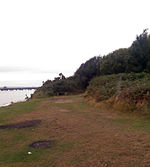River Hamble
River navigations in the United KingdomRivers of HampshireUse British English from September 2017

The River Hamble is located in south Hampshire, England. It rises near Bishop's Waltham and flows for 10.1 km (6.3 mi) through Botley, Bursledon, and Lower Swanwick before entering Southampton Water between Hamble Common and Warsash. The Hamble is tidal for about half its length and is navigable below Botley. From the medieval period to the present it has been a major ship and boat-building area. Leisure craft are still built by the Hamble today. One of the main builders was Luke & Co, later Luke Bros, a well-reputed yard from around 1890 to its closure in 1945. The lower reaches are a major yachting area with easy access to the sheltered waters of Southampton Water and The Solent.
Excerpt from the Wikipedia article River Hamble (License: CC BY-SA 3.0, Authors, Images).River Hamble
Geographical coordinates (GPS) Address Nearby Places Show on map
Geographical coordinates (GPS)
| Latitude | Longitude |
|---|---|
| N 50.841601 ° | E -1.312546 ° |
Address
Berth 5
SO45 1TW
England, United Kingdom
Open on Google Maps










